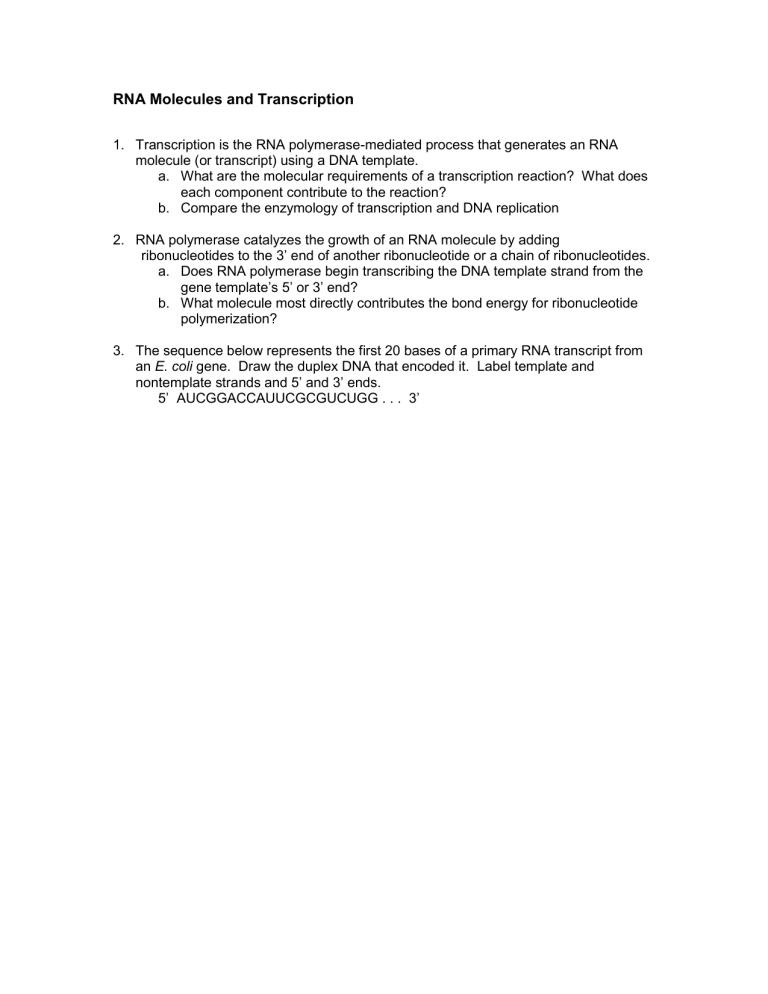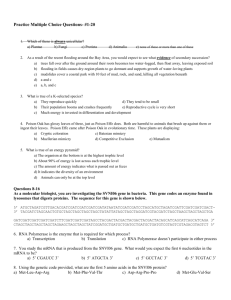DNA Replication, RNA Molecules and Transcription

RNA Molecules and Transcription
1. Transcription is the RNA polymerase-mediated process that generates an RNA molecule (or transcript) using a DNA template. a. What are the molecular requirements of a transcription reaction? What does each component contribute to the reaction? b. Compare the enzymology of transcription and DNA replication
2. RNA polymerase catalyzes the growth of an RNA molecule by adding ribonucleotides to the 3’ end of another ribonucleotide or a chain of ribonucleotides. a. Does RNA polymerase begin transcribing the DNA template strand from the gene template’s 5’ or 3’ end? b. What molecule most directly contributes the bond energy for ribonucleotide polymerization?
3. The sequence below represents the first 20 bases of a primary RNA transcript from an E. coli gene. Draw the duplex DNA that encoded it. Label template and nontemplate strands and 5’ and 3’ ends.
5’ AUCGGACCAUUCGCGUCUGG . . . 3’
Answers RNA Molecules and Transcription
1. a. A transcription reaction requires a DNA molecule to serve as template for transcription with a promoter (and, in vivo , transcription factors) to indicate where to begin transcribing and which strand to transcribe. Transcription reactions also require an RNA polymerase that recognizes the promoter on the DNA, NTPs to serve as the building blocks and donors of bonding energy, and a buffered salt solution for optimal RNA polymerase activity. b. (A) DNA polymerases polymerize deoxyribonucleotides ; RNA polymerase polymerizes ribonucleotides . (B) DNA polymerases require a primer to provide a 3’ OH group to add deoxyribonucleotides to; RNA polymerase needs no such primer. (C) DNA polymerases begin DNA replication at origins of replication ; RNA polymerases begin transcribing at the promoters of genes.
Both DNA and RNA polymerases synthesize chains of nucleotides in a template-dependent fashion. Both polymerases add nucleotides by connecting the 5’
phosphate of a nucleoside triphosphate to the 3’ OH of the last base that was added (i.e., in the 5’ to 3’ direction) and interact with other proteins that assist in their functioning.
2. a. RNA polymerase begins transcribing a DNA template strand from the 3’ end of the template. b. NTPs contribute most of the bond energy for ribonucleotide polymerization.
The release of the pyrophosphate (PP i
) accompanies the formation of the phosphodiester bond.
3. 5’ A U
CGGACCA
UU
CGCG
U
C
U GG . . . 3’ Transcript
5’ ATCGGACCATTCGCGTCTGG . . . 3’ Nontemplate strand
3’ TAGCCTGGTAAGCGCAGACC . . . 5’ Template strand








